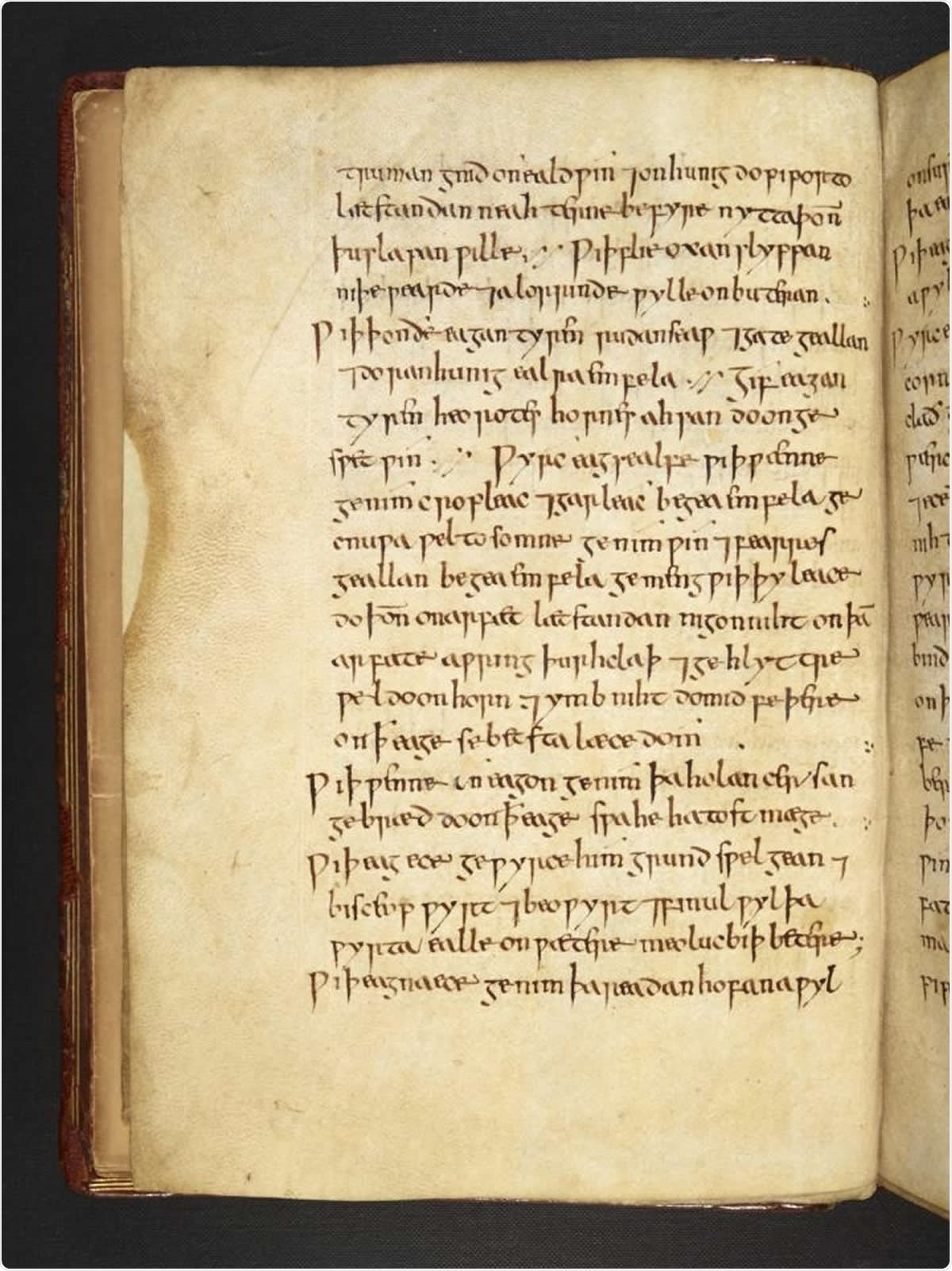Biofilm-associated infections are notoriously difficult to treat, and they also play a role in antibiotic resistance as more antimicrobials are urgently needed to treat biofilm-associated infections. These biofilms act as protective layers that prevent the antibiotics from reaching and destroying the targeted bacteria.
Now, researchers from the School of Life Sciences at the University of Warwick have found that a medieval mixture called the “Balds eye salve” could be effective against five bacteria that can cause these biofilms. Their study titled, “Anti-biofilm efficacy of a medieval treatment for bacterial infection requires the combination of multiple ingredients,” was published in the latest issue of the journal Scientific Reports.

The actual eyesalve remedy text. CREDIT © The British Library Board (Royal 12 D xvii)
What led to this study?
Antibiotic resistance is one of the significant emerging health problems, says the World Health Organization. More and more commonly used antibiotics are rendered useless against bacteria, which were earlier susceptible to these antibiotics. The authors of this study write that it is imperative that novel and new antimicrobials are developed to fight antibiotic resistance.
Dr. Freya Harrison, Jessica Furner-Pardoe, and Dr. Blessing Anonye were part of the Ancient biotics research team that was established in 2015. This included microbiologists, chemists, pharmacists, data analysts, and medievalists attached to institutes at Warwick, Nottingham, and in the United States.
Biofilms
Bacterial colonies can exist in two forms – isolated planktonic cells or as multicellular communities called biofilms. Biofilms are one of the common problems associated with antibiotic resistance. The team wrote that biofilm-related infections cost an estimated billion pounds to the National Health Service United Kingdom annually. They define biofilms as “communities of bacteria that produce a protective extracellular matrix and are especially persistent.” The researchers explain that removal of these biofilms requires 100–1,000 times higher antibiotic levels than usual. Further biofilms that occur within the body may be “completely impervious” to antibiotics used to treat them.
Natural materials and historical infection remedies
There is a need for novel antibiotics to fight off biofilms, and natural infection remedies have not been studied adequately in this context, say the researchers. They write, “Just 200 years ago, our pharmacopeia was dominated by herbal medicines”. These concoctions and mixtures could be used to treat bacterial cultures. These have, however, not shown much efficacy against biofilms. They explain that ancient remedies often contain more than one ingredient, which could serve the purpose better than single chemicals or compounds.
Groundwork and what was done in this study?
The team had recreated a 1000-year-old medicinal preparation called ‘Bald’s eyesalve’ using extracts of “onion, garlic, wine, and bile salts.” This recipe was obtained from the manuscript known as Bald’s Leechbook (London, British Library, Royal 12, D xvii) – a tenth-century book. One of their earlier studies has shown that this mixture had antibacterial activity. The mixture was found to be effective against Staph aureus, Pseudomonas aeruginosa, and Neisseria gonorrhoeae, they wrote.
What was found here?
Earlier studies had shown bacteria-killing property of this medicinal preparation. This bactericidal action was found to be present against several -negative and Gram-positive bacteria in this present study. These bacteria were commonly found in wounds, wrote the researchers. The action was seen against planktonic culture. The action was seen on biofilm model with wounds against bacteria including Acinetobacter baumannii (associated with wounds), Stenotrophomonas maltophilia (cause respiratory infections), Staphylococcus aureus (cause skin infections, abscesses, sinusitis, respiratory infections, food poisoning, etc.), Staphylococcus epidermidis (cause infections associated with prosthetics, catheters especially among those with compromised immunity) and Streptococcus pyogenes (cause tonsillitis, pharyngitis, cellulitis, rheumatic fever, glomerulonephritis, scarlet fever, etc.).
The researchers explained that garlic in the preparation could be one reason why there is an action against planktonic cultures. This garlic, however, does not affect the biofilms, they wrote. Bald’s eyesalve, however, is made up of more than one ingredient, and this combination could be the reason why it shows efficacy against biofilms, they wrote.
Conclusions and implications
Jessica Furner-Pardoe, from the Medical School at the University of Warwick, also said, “Our work demonstrates just how important it is to use realistic models in the lab when looking for new antibiotics from plants. Although a single component is enough to kill planktonic cultures, it fails against more realistic infection models, where the full remedy succeeds.”
The authors wrote in conclusions, “Our work highlights the need to explore not only single compounds but also mixtures of natural products for treating biofilm infections and underlines the importance of working with biofilm models when exploring natural products for the anti-biofilm pipeline.”
Dr. Freya Harrison, from the School of Life Sciences at the University of Warwick, said in her statement, “We have shown that a medieval remedy made from onion, garlic, wine, and bile can kill a range of problematic bacteria grown both planktonically and as biofilms. Because the mixture did not cause much damage to human cells in the lab, or mice, we could potentially develop a safe and effective antibacterial treatment from the remedy.” She added, “Most antibiotics that we use today are derived from natural compounds, but our work highlights the need to explore not only single compounds but mixtures of natural products for treating biofilm infections. We think that future discovery of antibiotics from natural products could be enhanced by studying combinations of ingredients, rather than single plants or compounds. In this first instance, we think this combination could suggest new treatments for infected wounds, such as diabetic foot and leg ulcers.”
Journal reference:
Furner-Pardoe, J., Anonye, B.O., Cain, R. et al. Anti-biofilm efficacy of a medieval treatment for bacterial infection requires the combination of multiple ingredients. Sci Rep 10, 12687 (2020). https://doi.org/10.1038/s41598-020-69273-8